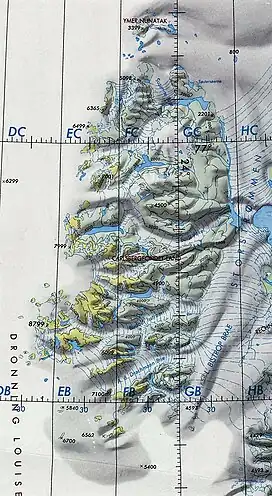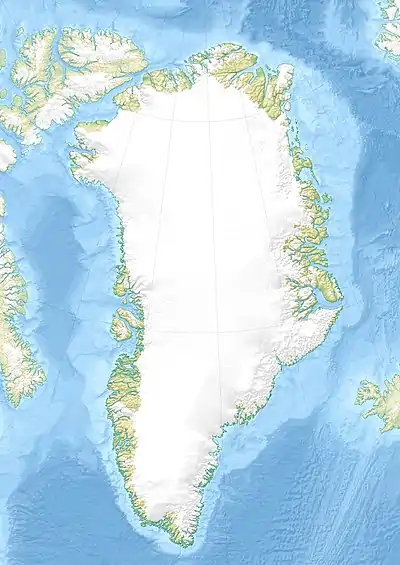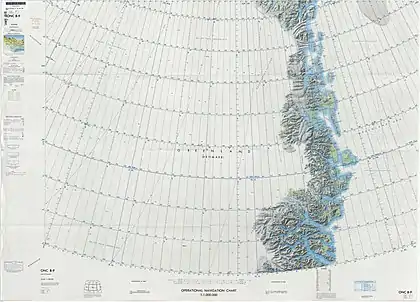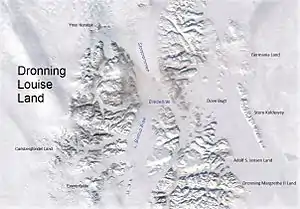| Storstrommen | |
|---|---|
| Storstrømmen | |
 Queen Louise Land ONC map section with the Storstrommen in the upper right. | |
 Location within Greenland | |
| Type | Piedmont glacier |
| Location | Greenland |
| Coordinates | 77°0′N 22°40′W / 77.000°N 22.667°W |
| Area | 32,100 km2 |
| Length | 125 km |
| Width | 26 km |
| Terminus | Borg Fjord through Bredebrae; North Atlantic Ocean |
Storstrommen (Danish: Storstrømmen, meaning "Large Stream"), is one of the major glaciers in northeastern Greenland.[1] The North-East Greenland Ice Stream (NEGIS) discharges into 3 main marine-terminating outlets: 79N Glacier, Zachariae Isstrøm and Storstrommen - as arranged North to South.[2]
Storstrommen's ice flows at an average of 185m/yr,[3] an order of magnitude slower than its Northern cousins. This is suggested as this outlet sits on higher elevations, where the subglacial topography and hydro-dynamics pin and slow glacier flow, relative to predominantly marine-based 79N and Zachariae Isstrøm. All 3 outlets see an increased ice velocity in the summer months,[4] as surface meltwater is fed into the subglacial environment, saturating highly-malleable tills and lubricating the over-riding glacier's movement.
Storstrømmen was named because of its size. It was given this name by the ill-fated 1906–08 Denmark Expedition (Danmark-Ekspeditionen) led by Ludvig Mylius-Erichsen.[5]
Surge-type characteristics
Storstrommen is widely recorded to be a surge-type glacier, which has recently experienced a form of "Quiescence" and slower movement.[6][7] The last "surge" was recorded by Mouginot and others in 2018 [2]to have ended in 1990. The glacier has been in a quiescent state since, although there are suggestions it will reach the required pre-surge conditions by 2027-2030. Grounding-line retreat is noted by the same article to be approximately 400m/yr, and the "dynamic cycling" of temperature and precipitation (which alters glacier mass-balance) is thought to be causing this.[7]
Storstrommen's companion glacier "Bistrup Brae" last surged between 1988 and 1996.[2]
Geographical Context
The mighty Storstrommen is roughly north–south oriented and has a width of over 20 km. Queen Louise Land (Dronning Louise Land) lies to the west and Daniel Bruun Land to the east.[5] Both areas see a large number of nunataks extending above the ice surface. The nunataks present a viable albedo-feedback mechanism, which preferentially forms supraglacial lakes at the margins of many of the outlets in the area. [8]
Flowing southwards for over 125 kilometers from the area of the Alabama Nunatak, its front is in the Bredebrae,[9] the confluence of two very large glaciers, the Storstrommen flowing from the north and the almost equally large L. Bistrup Brae from the south.[5]
The Storstrommen is part of an extensive glacier system that includes as well the Kofoed-Hansen Glacier (Kofoed-Hansen Bræ) to the NE and the Borgjokel to the SW.[9][10][11]
 Map of Northeastern Greenland. |
 Storstrommen east of Queen Louise Land. |
See also
References
- ↑ "Storstrømmen". Mapcarta. Retrieved 21 April 2016.
- 1 2 3 Mouginot, J.; Rignot, E.; Scheuchl, B.; Fenty, I.; Khazendar, A.; Morlighem, M.; Buzzi, A.; Paden, J. (2015-11-12). "Fast retreat of Zachariae Isstrom, northeast Greenland". Science. 350 (6266): 1357–1361. doi:10.1126/science.aac7111. ISSN 0036-8075. PMID 26563135.
- ↑ Vijay, Saurabh; Khan, Shfaqat Abbas; Kusk, Anders; Solgaard, Anne M.; Moon, Twila; Bjørk, Anders Anker (2019-02-09). "Resolving Seasonal Ice Velocity of 45 Greenlandic Glaciers With Very High Temporal Details". Geophysical Research Letters. 46 (3): 1485–1495. doi:10.1029/2018gl081503. ISSN 0094-8276. S2CID 135069457.
- ↑ Neckel, Niklas; Zeising, Ole; Steinhage, Daniel; Helm, Veit; Humbert, Angelika (2020-05-27). "Seasonal Observations at 79°N Glacier (Greenland) From Remote Sensing and in situ Measurements". Frontiers in Earth Science. 8. doi:10.3389/feart.2020.00142. ISSN 2296-6463.
- 1 2 3 "Catalogue of place names in northern East Greenland". Geological Survey of Denmark. Retrieved 21 April 2016.
- ↑ Clarke, Garry K. C.; Schmok, Jeffrey P.; Ommanney, C. Simon L.; Collins, Sam G. (1986-06-10). "Characteristics of surge-type glaciers". Journal of Geophysical Research: Solid Earth. 91 (B7): 7165–7180. doi:10.1029/jb091ib07p07165. ISSN 0148-0227.
- 1 2 Sevestre, Heïdi; Benn, Douglas I. (2015). "Climatic and geometric controls on the global distribution of surge-type glaciers: implications for a unifying model of surging". Journal of Glaciology. 61 (228): 646–662. doi:10.3189/2015jog14j136. hdl:10023/8342. ISSN 0022-1430.
- ↑ Stokes, Chris R.; Sanderson, Jack E.; Miles, Bertie W. J.; Jamieson, Stewart S. R.; Leeson, Amber A. (2020-01-31). "Author Correction: Widespread distribution of supraglacial lakes around the margin of the East Antarctic Ice Sheet". Scientific Reports. 10 (1): 1923. doi:10.1038/s41598-020-58950-3. ISSN 2045-2322. PMC 6992625. PMID 32001806.
- 1 2 Fluctuations of Glaciers 1990-1995 (Vol. VII)
- ↑ Storstrømmen susceptible to rapid retreat
- ↑ Neoglacial glacier changes around Storstrommen, North-East Greenland